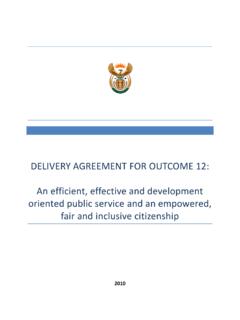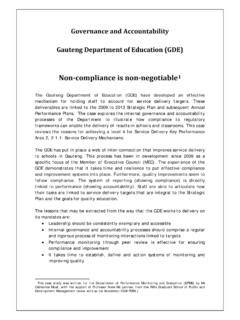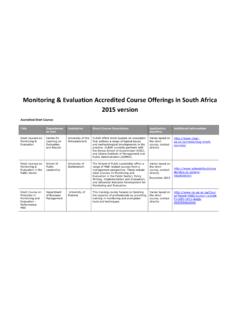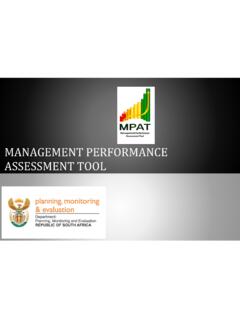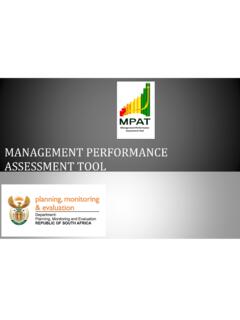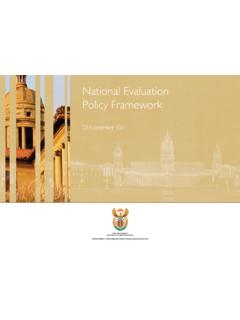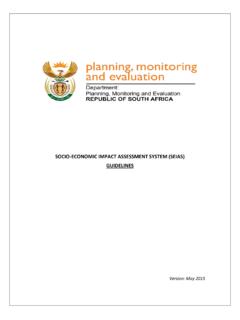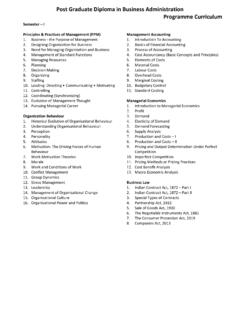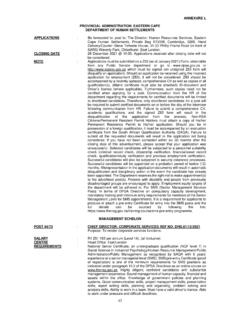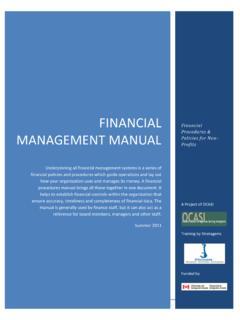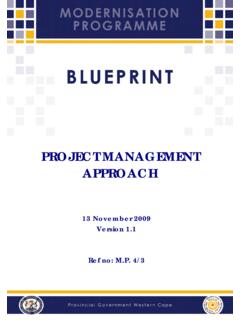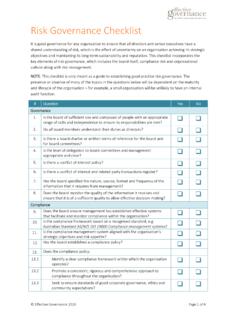Transcription of Policy framework for the Government-wide Monitoring and ...
1 Policy framework for the Goverment-wideMonitoring and Evaluation SystemPublished by THE PRESIDENCYP rivate Bag X115 Pretoria0001 South AfricaTel: +27 12 315 5948 Fax: +27 12 315 5126 Website: framework for the Goverment-wide Monitoring and Evaluation SystemsLayout: Internal CommunicationsPrinting and Binding: Shereno PrintersPublication date: November 2007 ISBN: 978-0-621-37563-3RP: 241/2007 Principles of M& Contributes to improved governance Rights-based Developmentally-oriented Should be undertaken ethically Utilization-oriented Methodologically sound Operationally What are Monitoring and evaluation systems? Defi nition of an M&E system What the GWM&E system is not Relationship between institutional M&E systems and the GWM&E system System overview Aim of the GWM&E system Overview System description Flowchart System goals PART ONE: UNDERSTANDING Monitoring AND EVALUATION (M&E) PART TWO: THE Government-wide Monitoring AND EVALUATION (GWM&E) SYSTEMP olicy framework for the Government-wide Monitoring and Evaluation Why is Monitoring and evaluation important?
2 The importance of M&E Defi nition of Monitoring : Are we doing things right? Defi nition of evaluation: Are we doing the right things? Key M&E The three data terrains underpinning the GWM&E system Programme performance information Social, economic and demographic statistics EvaluationsPage 1 Page 3 Page 4 Page 5 Page 7 About this Policy framework and its Building capacity Capacity requirements The purpose of M&E capacity building Capacity building interventions M&E skill Institutional Legal mandate underpinning GWM&E roles and responsibilities Presidency National Treasury Statistics SA Department of Public Service and Administration Department of Provincial and Local Government Offi ce of the Public Service Commission South African Management Development Institute Auditor General Provincial Premier s Offi Guiding principles for implementation Defi ning roles and responsibilities Legislators
3 Executive authorities Accounting offi cers Programme managers, line managers and other offi cials Designated M&E The practice of M&E Building demand by meeting needs A central repository Follow up Knowledge sharing PART FOUR: IMPLEMENTING THE GWM&E Linking M&E with other managerial systems Overview M&E strategies PART THREE: M&E AT INSTITUTIONAL LEVEL Structures and Integration of M&E with other managerial processesPage 11 Page 13 Page 14 Page 15 Page 17 Policies and strategies, programmes and projects Result-based management Evidence based decision making Data; information and knowledge Baselines Performance indicators and means of verifi cation APPENDIX 1: KEY CONCEPTS IN Monitoring AND EVALUATIONPage 19 Page 17 Page 22 What you should know.
4 After reading this Policy framework for Government-wide Monitoring & Evaluation, you should understand the following critical issues: Key Monitoring & evaluation (M&E) concepts and principles The importance of M&E as a tool for the public sector to evaluate its performance and identifying the factors which contribute to its service delivery outcomes The composition of the Government-wide Monitoring & Evaluation (GWM&E) system and intended outcomes The relationship between institutional M&E systems and the GWME system The relationship of the GWME framework to the three critical M&E data terrains: Programme Performance Information; Social, Economic and Demographic Statistics and Evaluations The role of M&E strategies and fi ndings in supporting planning, budgeting , programme implementation, fi nancial management and reporting processes The roles and responsibilities of government offi cials as implementing agents of M&E Capacity building interventions required to manage and effectively utilise M&E The institutional arrangements of the GWM&E system and the legal mandate underpinning roles and responsibilitiesPolicy framework for the Goverment-wide Monitoring and EvaluationPART ONE:UNDERSTANDING Monitoring AND EVALUATION Why is Monitoring and evaluation important?
5 This document is the overarching Policy framework for Monitoring and evaluation in the South African Government. It sketches the Policy context for supporting frameworks, such as National Treasury s framework for Managing Programme Performanceinformation and Statistics South Africa s South African StatisticsQuality Assurance framework . It is further supplemented by an outline of the legislative mandates of the various stakeholders charged with its implementation. It also provides a section on principles which will guide future implementation Policy framework is applicable to all entities in the national, provincial and local spheres of importance of M&E Government s major challenge is to become more effective. M&E processes can assist the public sector in evaluating its performance and identifying the factors which contribute to its servicedelivery outcomes.
6 M&E is uniquely oriented towards providing its users with the ability to draw causal connections between the choice of Policy priorities, the resourcing of those Policy objectives, the programmes designed to implement them, the services actually delivered and their ultimate impact on communities. M&E helps to provide an evidence base for public resource allocation decisions and helps identify how challenges should be addressed and successes replicated. Monitoring and evaluation is, however, extremely complex, multi-disciplinary and skill intensive. Government-wide Monitoring and evaluation even more so, since it requires detailed knowledge both across and within sectors, and interactions between planning, budgeting and implementation. The picture is complicated even further when the machinery of government is decentralised, with powers and functions being distributed across three spheres of government.
7 It is precisely this complicated intergovernmental structure with diffused powers and functions which requires strong M&E systems to promote coordination and prevent nition of Monitoring Monitoring involves collecting, analysing, and reporting data on inputs, activities, outputs, outcomes and impacts as well as external factors, in a way that supports effective management. Monitoring aims to provide managers, decision makers and other stakeholders with regular feedback on progress in implementation andAbout this Policy framework and its applicabilityKey M&E conceptsDefi nition of EvaluationEvaluation is a time-bound and periodic exercise that seeks to provide credible and useful information to answer specifi c questions to guide decision making by staff, managers and Policy makers. Evaluations may assess relevance, effi ciency, effectiveness, impact and sustainability.
8 Impact evaluations examine whether underlying theories and assumptions were valid, what worked, what did not and why. Evaluation can also be used to extract cross-cutting lessons from operating unit experiences and determining the need for modifi cations to strategic results and early indicators of problems that need to be corrected. It usually reports on actual performance against what was planned or nition of Monitoring Inputs: all the resources that contribute to the production of service delivery outputs. Inputs are what we use to do the work . They include fi nances, personnel, equipment and : the processes or actions that use a range of inputs to produce the desired outputs and ultimately outcomes. In essence, activities describe what we do .Outputs: the fi nal products, goods and services produced for delivery.
9 Outputs may be defi ned as what we produce or deliver .Outcomes: the medium-term results for specifi c benefi ciaries which are the consequence of achieving specifi c outputs. Outcomes should relate clearly to an institution s strategicgoals and objectives set out in its plans. Outcomes are what we wish to achieve . Outcomes are often further categorizedinto immediate/direct outcomes and intermediate : the results of achieving specifi c outcomes, such as reducing poverty and creating jobs. Impacts are how we have actually infl uenced communities and target groups .As noted before, M&E revolves around a number of key elements: Policy framework for the Goverment-wide Monitoring and Evaluation7. M&E should be operationally effective Systematic Planned Scope Managed Cost effective As an integrated component of public management, M&E is routine and regularized.
10 The scale of M&E refl ects its purpose, level of risk and available resources. Conscientious management of the function leads to sustained on-time delivery of excellence. The benefi ts of M&E are clear and its scale is appropriate given resource availability. Robust systems are built up that are resilient and do not depend on individuals or chance. Principles of M&E1. M&E should contribute to improved governance Transparency All fi ndings are publicly available unless there are compelling reasons otherwise. Accountability Use of resources is open to public scrutiny. Participation Voice is provided to historically marginalized people. Inclusion Traditionally excluded interests are represented through out M&E processes. 5. M&E should be utilisation oriented Defi ning and meeting expectations Supporting utilisation M&E products meet knowledge and strategic needs.
